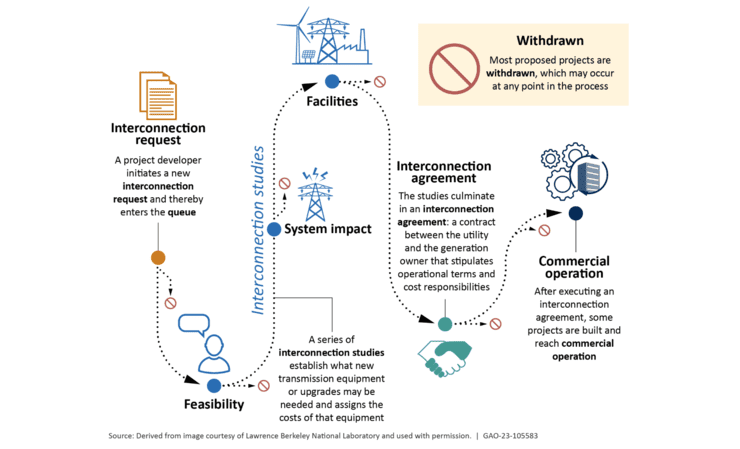Navigating the Interconnection Queue Is One of Many Challenges Clean-Energy Projects Face
There are several obstacles to overcome when building a clean-energy project, but perhaps the biggest is getting through the generator interconnection queue (GIQ). Every regional transmission organization (RTO) and independent system operator (ISO) in the U.S. has a significant backlog in its GIQ and processing interconnection requests can take years to complete. This has created a significant barrier to deploying renewable energy, as companies often face long wait times, and high costs for new transmission lines and other upgrades when the local grid is near or at capacity.
Part of the problem is the complexity of the interconnection process, which involves multiple studies (Figure 1). The Midcontinent Independent System Operator (MISO) reports that historically about 70% of projects submitted to its queue ultimately withdraw, resulting in extensive rework and delays, as studies must be redone when projects withdraw.

MISO recognizes change is necessary and has implemented some reforms. On Jan. 19, 2024, the Federal Energy Regulatory Commission (FERC) accepted MISO’s filing (ER24-340) to increase milestone payments, adopt an automatic withdrawal penalty, revise withdrawal penalty provisions, and expand site control requirements. These provisions were designed to help expedite the GIQ process, and maximize transparency and certainty. MISO said the filing was developed through extensive collaboration in the stakeholder process, including multiple discussions in the Planning Advisory Committee and Interconnection Process Working Group. MISO expects these reforms to reduce the number of queue requests withdrawing from the process. It said the fewer projects in studies, the quicker the evaluations can be completed, and the fewer projects that withdraw, the more certain phase 1 and 2 study results are.
Still, it’s likely that more needs to be done to improve the GIQ process. The Clean Grid Alliance (CGA), a nonprofit organization that works to advance renewable energy in the Midwest, conducted a survey of 14 clean energy developers who’ve had solar, wind, hybrid, and battery storage projects in the MISO interconnection queue over the last five years to better understand the challenges they’ve faced. Survey respondents included developers who have been working in nearly every MISO North and South state, with queue projects sited in Arkansas, Illinois, Indiana, Iowa, Louisiana, Michigan, Minnesota, Mississippi, Missouri, North Dakota, and Wisconsin.
“We’re still unpacking the survey a bit—still finding out and figuring out how we should communicate about what we found—but we’re starting to do that,” Beth Soholt, executive director of the CGA, said as a guest on The POWER Podcast. “There are categories of things that we found,” she said.
“On the technical side, the queue reform order 2023 is working its way through FERC. There’ll be compliance filings required from the RTOs and ISOs. How far does that get us? What does that get us?” Soholt asked rhetorically. “There will be a transition period, and developers right now are really trying to understand what it means for their projects and adjusting to that new reality,” she continued. “I don’t think we know yet how much it will fix the queue problem, because it’s going to take a little while to kind of ripple down through the process until we really know.”
Aside from interconnection queue challenges, the CGA survey also identified other hindrances to clean-energy project development. “I think I underappreciated the impact COVID had on development,” noted Soholt. “For instance, while MISO and other RTOs found a way to keep going with virtual meetings and not having to come together in person, that wasn’t always true at the local level—in gathering land for projects, in getting permits, in educating communities about the benefits. And so, there was a slow-down period and just a period where local folks didn’t want to see anybody or talk to anybody face to face.”
Soholt explained that a lot of development work is done face to face, so that was a big problem that also had a ripple effect. Some leases that developers had negotiated began to expire, so they had to go back out to communities and renegotiate. “Land control is really, really, really important, and COVID had a very pronounced effect on that,” Soholt said.
“Siting in general is getting more difficult, as we do more volume, as we do transmission in the MISO footprint,” said Soholt. “We need new generation to be sited, we need new transmission, and we have to find a pathway forward on that community acceptance piece,” she said.
Among other challenges, Soholt said some projects saw generator interconnection agreements (GIAs) timing out and needing MISO extensions. Meanwhile, transmission upgrade delays also presented problems, not only the large backbone transmission upgrades, but also the transmission owners building interconnections for individual projects to connect breakers, transformers, and other equipment. Soholt said longer and longer component lead times presented timing challenges, which were also problematic for developers. These were all important takeaways from the CGA survey, and items the group will work to resolve.
Yet, for all the difficulties, Soholt seemed optimistic that MISO would continue to find ways to improve the process. “When we get overwhelmed, we really step back and say, ‘What’s going to be the best thing to work on to really make a difference?’ So far, that really has been the big things like transmission planning. We feel good about where that’s at in MISO—they are doing good long-range planning,” Soholt said.
To hear the full interview with Soholt, which contains more about the benefits of energy storage, lessens other RTOs and ISOs have learned, and how CGA helps its members have a voice in discussions, listen to The POWER Podcast. Click on the SoundCloud player below to listen in your browser now or use the following links to reach the show page on your favorite podcast platform:
For more power podcasts, visit The POWER Podcast archives.
—Aaron Larson is POWER’s executive editor (@AaronL_Power, @POWERmagazine).